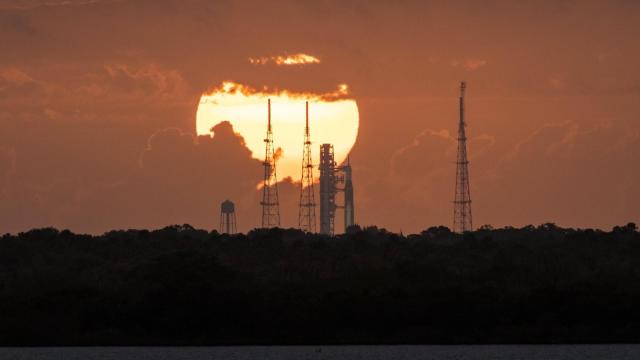NASA wrapped up its fourth wet dress rehearsal of the Space Launch System yesterday, during which time ground teams achieved a number of key test objectives. That said, an unresolved hydrogen leak prevented a full completion of the test, in a development that could further complicate the Artemis 1 mission schedule.
Yesterday’s wet dress rehearsal ended at 7:37 p.m. ET, with ground teams successfully managing to fill both rocket stages with supercold liquid oxygen and liquid hydrogen propellants — something they hadn’t been able to achieve during the first three rehearsal attempts. The teams also practiced a terminal countdown, but the clock was stopped at T-29 seconds instead of the intended T-10 second mark. The rocket has been drained of its propellant and it remains standing on Launch Pad 39B at Kennedy Space Centre in Florida as launch controllers determine next steps.
A hydrogen leak was the reason for terminating the countdown prematurely, in a decision made earlier on Monday, NASA officials told reporters today. Those missing 19 seconds may not sound like much, but the final moments prior to launch involve a ton of moving parts. It therefore cannot be said that NASA performed a full wet dress rehearsal of its mega Moon rocket. NASA officials aren’t yet ready to say if a fifth wet dress rehearsal will be required or if SLS is finally ready for its inaugural launch, a mission known as Artemis 1. The upcoming Artemis missions could see a man and woman land on the lunar surface by 2025, the construction of the first lunar space station, and a long-awaited permanent presence at and around the Moon — but it all starts with SLS.
That the rocket’s tanks were fully loaded with propellants and a countdown brought so close to the finish line — and all the things that have to happen before and in-between — is still a big deal. At today’s media teleconference, Tom Whitmeyer, NASA’s deputy associate administrator for Common Exploration Systems Development, said “these are really important things that we wanted to see.” Whitmeyer described the jumbo rocket as a complicated jigsaw puzzle, and the recently concluded wet dress means “we now have a really good idea of what the puzzle looks like,” but a few unspecified outstanding items need to be analysed. Ground teams also “gotta chase the leak,” he said.
Indeed, the hydrogen leak ruined an otherwise uneventful launch rehearsal. This leak happened as propellants were being poured into the rocket; crews sourced the problem to the core stage tail service mast umbilical quick disconnect, the point where the line connecting the rocket and the mobile launcher become separated during launch. During the wet dress, ground teams worked feverishly to resolve the issue by warming the quick disconnect and then re-aligning it to form a tight seal, but it didn’t work.
Now, under a normal launch scenario, such a leak would’ve undoubtedly resulted in a scrub, but launch controllers wanted to keep the rehearsal going. They “developed a plan to mask data associated with the leak that would trigger a hold by the ground launch sequencer, or launch computer, in a real launch day scenario, to allow them to get as far into the countdown as possible,” according to a NASA statement. This allowed for a rehearsal of the terminal count (the final 10 minutes of a countdown), including a key step in which the ground launch sequencer is switched to the automatic launch sequencer controlled by SLS’s flight software. But for safety reasons, the countdown had to be stopped shortly after the T-33 second transition, owing to the hydrogen bleed line leak issue, as the NASA officials explained at the press conference.
The words “success” and “successful” were thrown around liberally during today’s press briefing, but it’s fair to say that (1) the fourth wet dress rehearsal was incomplete (even if slightly) so, (2) the rocket wouldn’t have launched, had it been a non-rehearsal scenario, and (3) the unresolved hydrogen leak is clearly a problem that needs work. These concerns aside, the plethora of issues that plagued the first three wet dress attempts appear to have been fully resolved, and the Orion capsule is performing “nominally,” as the NASA officials told me during the briefing.
Charlie Blackwell-Thompson, Artemis launch director, said the teams got through many test objectives, but some objectives were not met during the terminal count. She and her colleagues need to evaluate the data such that they can come back with a recommendation on how to proceed, Blackwell-Thompson said, saying no decision has been made about whether another launch rehearsal is required. Mike Sarafin, Artemis mission manager at NASA, chimed in, saying the teams will look “at the risks of not performing another test.”
I’m a practice-makes-perfect sort of guy, so my own feeling is that NASA should perform a fifth test. SLS is being positioned as a workhorse vehicle for the next decade or two, so another test doesn’t seem like a big deal, especially given that the rocket is still on the launch pad and because only a few final details need to be ironed out. A number of Artemis launch windows remain available for NASA, including opportunities in late August and late September. NASA officials said they’re looking to meet with the press later this week, so we may learn the answer in short order.
More: Test to Manoeuvre ISS with Cygnus Spacecraft Didn’t Go as Planned.
